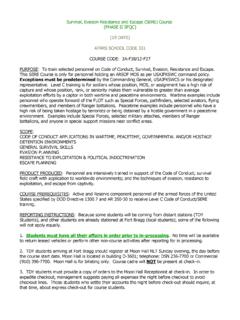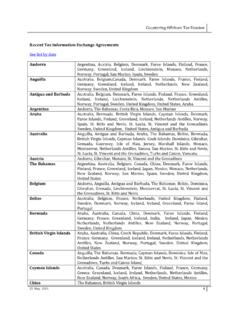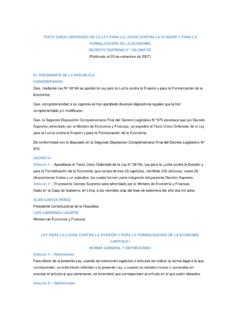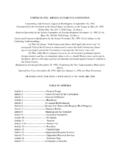Transcription of Technology Tools to Tackle Tax Evasion and Tax Fraud
1 Technology Tools to Tackle Tax Evasion and Tax Fraud This document, as well as any data and map included herein, are without prejudice to the status of or sovereignty over any territory, to the delimitation of international frontiers and boundaries and to the name of any territory, city or credits: all images courtesy of OECD 20171 Table of contentsTECHNOLOGY Tools TO Tackle TAX Evasion AND TAX FRAUDE xecutive summary .. 3 Chapter 1. Introduction: A compelling case .. 5 Chapter 2. Electronic sales suppression and counter- Technology .. 9 What is the problem? .. 10 What solutions can address electronic sales suppression? .. 11 What are the results and benefits? .. 11 What features do these solutions have? .. 13 What are the costs? .. 14 What other actions are needed to implement the solution? .. 14 Chapter 3. False invoicing .. 17 What is the problem? .. 18 What solutions can address false invoicing?
2 18 What are the results and benefits? .. 19 What features do these solutions have? .. 19 What other actions are needed to implement the solution? .. 20 Chapter 4. The cash economy and the sharing economy: Complementary work to address the risks .. 21 What are the challenges posed by the cash economy? .. 22 What work is being undertaken to address the cash economy? .. 22 What are the challenges posed by the sharing economy?.. 23 What work is being undertaken the sharing economy? .. 23 Chapter 5. Introducing Technology Tools : Best practice approaches .. 27 Chapter 6. Conclusion .. 31 Annex A. Catalogue of country solutions for electronic sales suppression .. 33 Annex B. Catalogue of country solutions for electronic invoicing .. 47 Bibliography .. 54 OECD 20172 OECD 20173 Executive summaryTECHNOLOGY Tools TO Tackle TAX Evasion AND TAX FRAUDW hile most taxpayers comply with their tax obligations, some are determined not to.
3 Tax Evasion and tax Fraud continues to occur and can be substantial, amounting to many billions per year. Not only is this against the law and defrauds the government of revenue, but it also creates an un-level playing field for compliant taxpayers. Many tax authorities around the world are seeing particular types of tax Evasion : under-reporting of income through electronic sales suppression and over-reporting of deductions through false invoicing. Tax Evasion and Fraud can be further facilitated by the cash economy and the sharing (or online) economy. However, cost effective Technology solutions are already available for tax authorities to implement, and which prevent and detect these types of tax Evasion and tax report draws on the experience of 21 countries in this area, including several developing countries, and highlights their key successes in using these Technology Tools .
4 Not only has substantial tax revenue been raised due to the reduction in tax Evasion and tax Fraud , but where these solutions have been implemented; a deterrent effect is shown, with overall increasing compliance by taxpayers. This report has been prepared with a view to encouraging other tax authorities to consider whether the same approach may be effective in their jurisdiction. It is the second in a series of reports focusing on the use of Technology and digital solutions to address tax Evasion , the first being the report Electronic Sales Suppression: A threat to tax revenue (OECD, 2013). This report is divided into four key parts: Electronic sales suppression and counter- Technology : the problem, the key features of available Technology solutions, the proven benefits as well as the costs, and the complementary actions needed to implement such solutions; False invoicing: the problem, the key features of available Technology solutions, the results and benefits, and the complementary actions needed to implement such solutions; OECD 20174 The cash economy and the sharing economy: the challenges posed by these segments of the economy and the work tax authorities are doing to address the cash and sharing economy.
5 And Best practices: the lessons from other tax authorities as to how these Technology solutions can be effectively annexes to the report contain a more detailed technical catalogue of the Technology solutions being used by tax authorities to address electronic sales suppression and false invoicing. To increase the potential for sharing of experience between tax authorities on the solutions they are using, the OECD Secretariat can also provide contact details for tax authorities to follow up on particular solutions contained in the Tools TO Tackle TAX Evasion AND TAX Fraud OECD 20175 Introduction: A compelling caseChapter 1 Chapter 1 OECD 20176 Chapter 1 Introduction: A compelling caseTECHNOLOGY Tools TO Tackle TAX Evasion AND TAX FRAUDTax Evasion and Fraud is illegal and intentional misrepresentation of tax obligations. It can involve deliberate omission or falsification of income or revenue, as well as efforts to be invisible to tax authorities altogether.
6 This results in the reduction of income that lawfully belongs to the government, and to the people. The loss of income can be substantial; for example, a study by European Commission reported that the total VAT Gap for 26 EU countries amounted to approximately EUR 193 billion in the year 2011 Evasion and tax Fraud not only cheats the public of revenue that is to be used for public goods, but also puts compliant taxpayers that obey the law at a disadvantage. It makes it harder for those compliant businesses to be profitable when they are competing with businesses that do not bear the expense of paying their fair share of particular types of tax Evasion and tax Fraud appear to be widespread in their use: underreporting of income through sales suppression and over-reporting of deductions through false invoicing. These are simple for criminals to achieve and can affect countries of all sizes.
7 These types of tax Evasion and Fraud can be further facilitated by the cash economy and sharing economy. The impact of this tax crime is huge, with anecdotal evidence alone indicating that it amounts to many billions of dollars in lost tax revenue. In the past, underreporting of income and over-reporting of deductions were difficult and time consuming for tax authorities to detect. This is changing. Many tax authorities are now using Technology solutions to detect these tax crimes. These solutions have been effective, and these tax authorities are making progress in bringing previously undetected and lost income into the revenue base, in a way that is also resource efficient for the tax authority. As more solutions become available in the market and the costs reduce, tax authorities have an opportunity to prevent and detect crime, significantly improve their revenue collection and increase the efficiency of their operations.
8 For this reason, the Task Force on Tax Crime and Other Crimes (TFTC) called for a report to publicise the importance and effectiveness of Technology solutions that are being used to detect tax Fraud and Evasion . This report was based on survey responses and discussions with 21 tax authorities1 on the solutions they are using or putting in place, as well as publicly available information and consultation with the private sector providers of the relevant Technology Information received from Argentina, Australia, Austria, Belgium, Canada, Finland, France, Germany, Ghana, Greece, Hungary, Italy, Kenya, Mexico, the Netherlands, the People s Republic of China, Rwanda, Singapore, Slovak Republic, Sweden, and the United Kingdom. OECD 20177 INTRODUCTION: A COMPELLING CASEThis report is not intended to be a comprehensive picture of all Technology solutions being used by tax authorities around the world.
9 Rather, it gives a clear picture of the direction that a number of tax authorities are taking, and should lead to further work on sharing information on other Technology solutions as they emerge. The report is divided into two sections. The first provides a brief overview of the types of Technology Tools that tax administrations have implemented to address tax Evasion and tax Fraud problems. Looking first at electronic sales suppression and then at false invoicing, it describes the problem, the key features of the Technology solutions being used to address the problem, the results, and the complementary Tools used to implement the solutions. The report then considers complementary work that is being undertaken to address the cash economy and sharing economy, which, although not types of tax Evasion and Fraud themselves, can facilitate Chart of solutions contained in this report ProblemSectorSolutionReport ReferenceUnder-reporting of incomeBusiness to consumer restaurant, bars, taxi, convenience storeData recording Technology in electronic cash registers / sales machines Chapter 2 and Annex AOver-reporting of deductionsBusiness to business construction Electronic invoicing and automated reporting Chapter 3 and Annex BLack of visibility of business activityCash and sharing economyLegal.
10 Policy and analytics Chapter 4 The second section in Annexes A and B is a more detailed catalogue of the Technology solutions being used to address electronic sales suppression and false invoicing, with a view to allowing other tax administrations that are facing the same types of challenges to draw on that report concludes that the case for the use of Technology to assist in countering tax Fraud and Evasion is compelling. To make the best use of these available Tools , tax authorities must continue to be proactive in sharing experience in order to stay abreast of the tax Evasion and Fraud techniques as they continue to evolve. OECD 20178 Chapter 2 OECD 20179 Electronic sales suppression and counter-technologyChapter 2 Chapter 2 OECD 201710At a basic level, sales suppression can be as simple as not recording some cash sales with the intention of under-reporting the amount of sales and thereby under-reporting the corresponding tax liability.


















